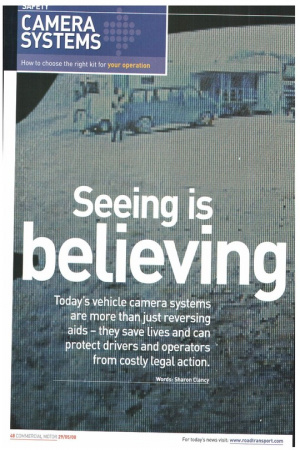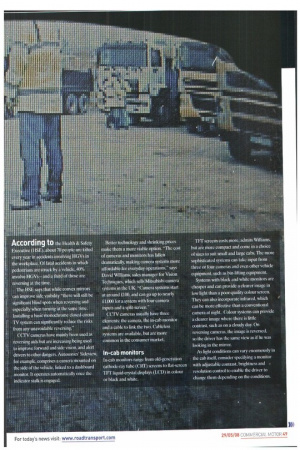Today's vehicle camera systems are more than just reversing aids
Page 48

Page 49

Page 50

If you've noticed an error in this article please click here to report it so we can fix it.
they save lives and can protect drivers and operators • from costly legal action.
Words: Sharon Clancy According to the Health & Safety Executive (USE), about 70 people are killed every year in accidents involving MA's in the workplace. Of fatal accidents in which pedestrians are struck by a vehicle, 40% . involve HCIVs and a third of those are reversing at the time.
The HSE says that while convex mirrors can improve side visibility -there will still he significant blind spots when reversing and . especially when turning at the same time. Installing a basic monochrome closed-circuit TV system can significantly reduce the risks from any unavoidable reversing."
CCTV cameras have mainly been used as reversing aids but are increasing being used to improve forward and side vision, and alert drivers to other dangers. Autosonics' Sideview, for example, comprises a camera mounted on the side of the vehicle, linked to a dashboard monitor. It operates automatically once the indicator stalk is engaged.
Better technology and shrinking prices make them a more viable option. -The cost of cameras and monitors has fallen dramatically, making camera systems more aftbrdable for everyday operations," says David Williams, sales manager for Vision Techniques, which sells Mitsubishi camera systems in the UK. "Camera systems start at around £1(X), and can go up to nearly €1,000 for a system with four camera inputs and a split-screen."
CCTV cameras usually have three elements: the camera, the in-cab monitor and a cable to link the two. Cableless :systems are available, but are more common in the consumer market.
In-cab monitors
In-cab monitors range from old-generation cathode-ray tube (CRT) screens to flat-screen IVY liquid-crystal displays (LCD) in colour or black and white.
'f FT screens costs more, admits Williams, but are more compact and come in a choice of sizes to suit small and large cabs. The more sophisticated systems can take input from three or four cameras and even other vehicle equipment. such as bin-lifting equipment. Systems with black and white monitors are cheaper and can provide a clearer image in low light than a poor-quality colour screen. They can also incorporate infrared, which can he more effective than a conventional ouriera at night. Colour systems can provide a clearer image where there is little contrast, such as on a cloudy day. On reversing cameras, the image is reversed, so the driver has the same view as if he was looking in the mirror.
As light conditions can vary enormously in the cab itself, consider specifying a monitor with adjustable contrast, brightness and resolution control to enable the driver to change them depending on the conditions.
Some monitors can adjust themselves automatically, and an integrated shield cuts glare.
The in-cab monitors can be placed at any suitable position in the cab, provided they are outside the swept area of the windscreen and do not obscure the side mirrors. Two popular spots are at mirror height on the driver's side corner pillar or centrally above the screen.
Cameras
At the rear, most cameras arc sited at the top, where they're less likely to get dirty and are out of the reach of thieves. Rear-mounted reversing cameras need to be centrally mounted, advises the HSE (unless there are two cameras, one on each side).
To find out how resistant to water and dirt a camera is, check its two-digit IP rating. These are awarded by the International Electrical Commission, and the higher the figure, the more resistant the equipment is to water and dirt ingress. So IP68, for example, is more dust and waterresistant than IP54.
Side-mounted cameras can be positioned anywhere convenient, although Autosonics' advice is to keep things simple. "We recommend fitting the camera beside existing mirrors, because it is capturing images in the driver's line of sight, so there is no confusion."
Mobileye combines three warning systems
Multi-function systems
Reverse-view cameras can be combined with other safety devices to provide more driver assistance. Brigade's Mobileye. for example, combines three systems in one device: lane departure warning, headway monitoring and warning, and forward collision warning. "Studies acros.s Europe and the USA have found that installing such systems can reduce lane-departure collisions by up to 65%," says Philip Hanson-Abbott, managing director.
Mobileye AWS 4000 includes a smart camera located on the front windshield inside the vehicle. It detects and measure distances to lanes and vehicles, and provides the driver with audio-visual alerts.
Forward collision warning detects vehicles and issues a warning 2.7 seconds prior to an impending collision, allowing the driver to react and avoid the accident. Lane departure warning monitors the position of the vehicle relative to the lane markings and again issues an alert in the event of unintentional lane crossing. Headway monitors the distance of the vehicle ahead, compares it with the speed of the vehicle in which it is installed, and then calculates the time to reach the vehicle ahead. This is displayed to the driver and warnings are issued when it decreases beyond a safe level.
Combined systems
Some safety experts are warning against over-reliance on CCTV and advise that cameras plus radar or ultrasonic proximity alarms may be more suitable for some operations. "While many vehicles are equipped with reversing cameras to protect the rear of the vehicle, they are only of use if the operator looks at the monitor during every reverse manoeuvre. If the operator doesn't look at the monitor, it might as well not be there," says Williams.
Vision Techniques has developed a version of its Sensor Vision quarry-vehicle radar system for transport workplaces called Banksman Radar. It works in conjunction with any CCTV system and comprises a radar head on the rear, linked to a separate in-cab monitor. It monitors the area to the rear and provides a reliable audible and visible reminder to the driver to check his camera monitor. Unlike ultrasonic sensors, any dirt does not affect the radar head and the use of a radar system called Frequency Modulated Constant Wave Radar has solved the problem of ineffectiveness over short distances.
The system can detect an object or person at up to 9.0m, utilising harmonic range gates, which fall at 0.75m linear increments. Two radar beams are produced, a wide beam and a narrow beam. The width/sensitivity of each of these can be programmed based on the operating area, and directional sensing technology is incorporated so that the system will only react to a closing distance between the radar and an object, minimising any false alarms. It can even incorporate speed thresholds to emit earlier or later warning, depending on the vehicle's speed.
Cameras, of course, are not much use in smoke, or conditions with high levels of dust or spray. For operations such as off-road work, Brigade has a new camera that works on thermal imaging and allow drivers to see five times further than with headlights in the dark, poor weather, dust and smoke. The camera works by detecting thermal radiation. Any object which has a temperature different to the ambient measurement is shown on the monitor: people, animals, wood, metal, debris, and changes in terrain. Brigade says the system can identify pedestrians and objects up to S00 metres away. •




































































































































































